Covenanter Trail
Laymore Conventicle Site
This natural amphitheatre was an ideal venue for open air services.
RPC
Grid Reference
The Covenanters
Covenanters are named after the National Covenant and the Solemn League and Covenant signed in Scotland in the mid 1600s. They believed Presbyterianism to be the only true form of church government. They stated that the King should have no authority over the church. Covenanters are also called Reformed Presbyterians. In 1644 the Solemn League and Covenant was brought to Ireland and signed in 26 places across Ulster, including Ballymena. By the time this occurred, the area had been heavily settled with Scots.
The Round Hole
The 1660s to 1680s was a time of persecution for Covenanters. During these times and for a long period after, Covenanters formed themselves into societies which were composed of local family groups. They were so successful that they continued for over 60 years without a resident minister or meeting house. The Round Hole was a local meeting place for these societies.
It has been suggested that Covenanters had been meeting at the Round Hole, Laymore, since the 1670s. The Round Hole was used for meeting before the building of the Reformed Presbyterian meeting house at Cullybackey in 1789.
David Houston
One Covenanter who may have preached here is David Houston. Houston, a Scot, moved to Antrim in 1667 and became a popular preacher. He made regular trips to Scotland to preach to Covenanters. In 1679, he fought for the Covenanters against the forces of the Crown at the Battle of Bothwell Brig, Scotland. Following the battle, he is believed to have fled to the Glenwherry area near Ballymena. He is said to have raised men to defend the River Bann from Jacobites. He was described as having ‘a congregation of 500 resolute fellows that adhere to him’. When he died in 1696, he was buried in Connor graveyard. His tombstone inscription is recorded on a tablet on the lecture hall beside Kellswater Reformed Presbyterian Church.



